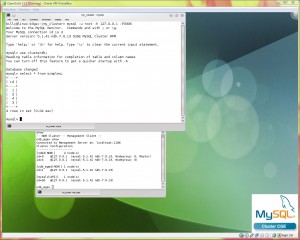
With the release of openSUSE 11.3 they announced the inclusion of MySQL Cluster. What does this mean as you could already install and run MySQL Cluster on openSUSE (and any other LINUX platform for that matter)? The change is that you can now use their tool (zypper) to install the MySQL Cluster RPMs and most importantly replace the ‘regular’ MySQL Server with the one that should be used with MySQL Cluster.
Personally I prefer installing MySQL Cluster from the tar ball as it gives me more control (for example, openSUSE is using MySQL Cluster 7.0 but I prefer to use 7.1 as that’s the latest GA release). Having said that, I was pleasantly surprised at how simple it was using the zypper tool (running as root):
|
1
2
3
4
5
6
7
8
9
10
11
12
13
14
15
16
17
18
19
20
21
22
23
24
25
26
27
28
29
30
31
32
33
34
35
36
37
38
39
40
41
42
43
44
45
|
<span style="color: #800000;">linux-b3ga:/home/billy # zypper install mysql-cluster Loading repository data... Reading installed packages... Resolving package dependencies... Problem: mysql-cluster-7.0.13-2.10.i586 conflicts with namespace:otherproviders(mysql) provided by mysql-community-server-5.1.46-2.18.i586 Solution 1: Following actions will be done: deinstallation of mysql-community-server-5.1.46-2.18.i586 deinstallation of mysql-community-server-client-5.1.46-2.18.i586 Solution 2: do not install mysql-cluster-7.0.13-2.10.i586 Choose from above solutions by number or cancel [1/2/c] (c): 1 Resolving dependencies... Resolving package dependencies... The following NEW packages are going to be installed: libmysqlclusterclient16 libmysqlclusterclient_r16 mysql-cluster mysql-cluster-client The following packages are going to be REMOVED: mysql-community-server mysql-community-server-client 4 new packages to install, 2 to remove. Overall download size: 8.4 MiB. After the operation, additional 1.4 MiB will be used. Continue? [y/n/?] (y): y Removing mysql-community-server-5.1.46-2.18 [done] Additional rpm output: Shutting down service MySQL ..done Removing mysql-community-server-client-5.1.46-2.18 [done] Retrieving package libmysqlclusterclient_r16-7.0.13-2.10.i586 (1/4), 484.0 KiB (1.4 MiB unpacked) Retrieving: libmysqlclusterclient_r16-7.0.13-2.10.i586.rpm [done (455.5 KiB/s)] Installing: libmysqlclusterclient_r16-7.0.13-2.10 [done] Retrieving package libmysqlclusterclient16-7.0.13-2.10.i586 (2/4), 483.0 KiB (1.4 MiB unpacked) Retrieving: libmysqlclusterclient16-7.0.13-2.10.i586.rpm [done (67.2 KiB/s)] Installing: libmysqlclusterclient16-7.0.13-2.10 [done] Retrieving package mysql-cluster-client-7.0.13-2.10.i586 (3/4), 150.0 KiB (339.0 KiB unpacked) Retrieving: mysql-cluster-client-7.0.13-2.10.i586.rpm [done] Installing: mysql-cluster-client-7.0.13-2.10 [done] Retrieving package mysql-cluster-7.0.13-2.10.i586 (4/4), 7.3 MiB (26.9 MiB unpacked) Retrieving: mysql-cluster-7.0.13-2.10.i586.rpm [done (583.8 KiB/s)] Installing: mysql-cluster-7.0.13-2.10 [done] </span> |
At this point the regular MySQL Server (mysqld) has been replaced with the one designed for use with MySQL Cluster (still works for other storage engines).
As I also want to run the management and data nodes on the same server, I installed those too (along with the tools):
|
1 |
<span style="color: #800000;">linux-b3ga:/home/billy # zypper in mysql-cluster-ndb-management</span> |
|
1 |
<span style="color: #800000;">linux-b3ga:/home/billy # zypper in mysql-cluster-ndb-storage</span> |
|
1 |
<span style="color: #800000;">linux-b3ga:/home/billy # zypper install mysql-cluster-ndb-tools</span> |
Once the installations are complete you can configure, fire up and test MySQL Cluster as described in previous post. Note that ndb_mgmd, ndbd/ndbmtd and mysqld will be in /usr/sbin while mysql_install_db, ndb_mgm and mysql will be in /usr/local/bin.
When you connect the mysql client, you’ll see a confirmation that you’re using the MySQL Cluster version of the MySQL Server:
|
1 |
<span style="color: #800000;">billy@linux-b3ga:~/my_cluster> mysql -u root -h 127.0.0.1 -P3306 </span> |
|
1
2
3
|
<span style="color: #800000;">Welcome to the MySQL monitor. Commands end with ; or g. </span><span style="color: #800000;">Your MySQL connection id is 2 </span><span style="color: #800000;"><strong>Server version: 5.1.41-ndb-7.0.13 SUSE MySQL Cluster RPM</strong></span> |